
Female Physical Beauty
Additional chapters in This Section include:
Gender Reassignment Surgery
Orchiectomy for MTF Transsexual Women
FFS Facial Feminization Surgery
MTF Transsexual Surgeries
Hormone Replacement Therapy for Transgender Women
Female Hormone Therapy MTF Transsexuals
Breast Development in MTF Transsexuals
MTF Transsexual Breast Enlargement
Breast Augmentation MTF Transsexuals
Lactation and the Transsexual Woman
Injecting Silicone for Transsexual Women
Brazilian Hips and Buttock Enlargement
Average Body Size MTF Transgender
Male and Female Skeleton Transsexuals
Treatment of Young Transsexuals
Puberty in Adolescents MTF Transgender
Treatment of Young MTF Transsexuals
Treatment of Intersex Infants
Androgen Insensitivity Syndrome
Female Physical Beauty Transgender
Transgender Female Beauty
Exercise, Fitness and Diet for Transsexual Women
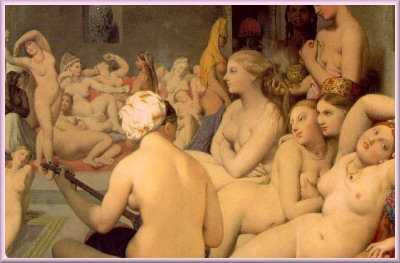
Introduction
|
Physical beauty in a woman may not be everything, but for good or bad it's certainly very important.

Would Prince Charming have asked Cinderella for a dance and fallen in love with her if she had not been the most beautiful girl at the ball? The honest answer is probably "No".
Psychological studies show that men still rank female beauty the highest among a long list of attributes that they seek in women. The phrase "I love you for your beauty" is hardly likely to be heard from the lips of a man in these politically correct days, but it is nevertheless often true, at least in the earliest stages of a relationship. A wonderful mind is great, but sometimes - like Cinderella - you also need the "beauty" to create the initial opening.
|
The immense amount of time and money that the average women spends on maintaining or improving her physical appearance has been given many justifications, but "I just like to look my best" is very close to "I just like to look beautiful".
|

It can be reasonably claimed that societies continuing lust for physical beauty is more appropriate to the Stone Age than to the modern Internet Age - the qualities that men find alluring in a woman may be powerful emblems of her health, fertility and resistance to disease, but they say nothing about her moral worth. The valuing of physical beauty may cause emotional pain and considerable injustice, but this does not prevent its continued worship - as a brief perusal of any magazine stand will prove.
|
The increasing number of lawsuits involving claimed discrimination on the basis of looks have made little impact to our attitude, nor have the best efforts of some feminist pressure groups to stop the supposed exploitation of women's body's (e.g. beauty contests) - indeed it can be argued that advances in cosmetics, plastic surgery and a constant media bombardment have increased the pressure on women to be "beautiful".
|
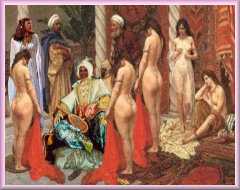
The Competition to be Beautiful
We might be in the 21st century but the brutal reality is that deep down most women know that their appearance and attractiveness to men (i.e. their beauty) matters ... and sometimes matters a lot.
|
Historically there were often many more adult women than available fit adult men - the dangers of hunting, warfare, long journeys etc. taking all too many men in their prime. For women, finding a husband to look after them could become a life and death matter, being more beautiful than your peers often meant the difference between a long life and even luxurious life - and starvation.
|
Gallery of Female Beauty
Some are almost certainly genetically XX, others almost certainly XY, and a few I'm not sure about. I'll let you try to work out which is which!
|


The Cinderella story still shows to all the young girls who are read it every night, beautiful young women are far more likely to marry "better", richer and socially higher husbands than the ugly sisters are - and it is certainly no coincidence that so many of the wives and mistresses of noblemen and royalty that we see in portraits dating back 200 years, 400 years, ... 600 years are often exceptionally beautiful women - even discounting some generous artistic license.
|
Even today, being beautiful definitely has practical advantages - for example pretty, tall, slim women
earn about 15% more
than their more dowdy, shorter, fatter counterparts. It is perhaps not surprising that women discuss the appearance and beauty of [other] women at least as much as men do, and far more brutally and critically
|
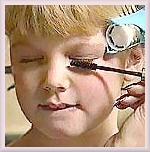
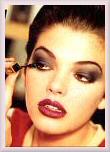
For many women, a concern about their looks is not just an important part of being female, but a fundamental of being themselves. Most mothers enjoy and take great pride in dressing up their daughters from the earliest age with make-up, hair accessories, jewelry and dresses. A young girl can expect to get more compliments on her appearance than anything else, and soon learns the rewards of looking pretty and being considered beautiful - all of which is reinforced by Cinderella type stories.
|

A girl's informal beauty lessons and training start by nursery age - and by her teens she will already have spent hundreds, if not thousands, of hours practicing and experimenting. During puberty, peer pressure often makes her appearance and looks become almost an obsession. Dissatisfaction is all too common - e.g. about half of all High School girls are on some form of weight control regime, and even plastic surgery is nowadays increasingly
desired!
|
It's relevant to this site to point out that a transsexual male-to-female woman who transitions as an adult lacks this lengthy childhood beautification "training". She thus faces an enormous challenge in developing as quickly as possible her female orientation, appearance and presentation - something which other women have been doing since their birth. This is a great disadvantage, and makes successful "
passing
" as a woman far more difficult, particularly in the first months after full time transition.
|
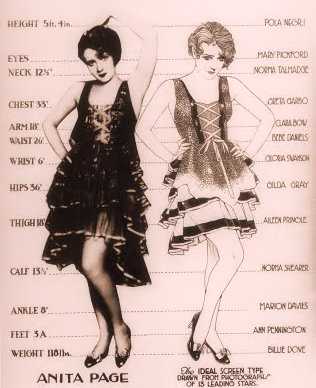
An interesting graphic from 1930 favorably comparing the physique of a popular 20 year old actress - Anita Page - against an ideal woman derived from the best parts of other leading actresses of the day. A modern model agency would immediately reject her as being too short and too fat. In 2012 the average female model was 4 inches taller than Anita (6 inches for top models), but rather worryingly about 10lbs lighter.
|

What is Female Beauty?
The experts tell us that the physical features and characteristics considered to be "beautiful" are in fact subconscious indicators of fertility and good health, while some other features and characteristics are considered to be "unattractive" because they render a person less fertile or more susceptible to disease and parasite assaults.
For example, a woman with an estrogenized small chin and a small waist-to-hip ratio appears to be beautiful because these are physical features that indicate good fertility, childbearing ability and general health. And of course a man has reciprocal features to indicate his facility to sire healthy children, and (apparently less importantly) support them and the mother.
|
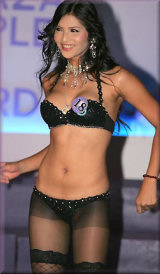
Judging beauty involves looking at another person and subconsciously figuring out whether you want your children to carry that person's genes. We judge each other by rules that we're often not even aware of. We may consciously admire Kate Moss's legs, but we're also viscerally attuned to small variations in the size and symmetry of facial bones and the placement of weight on the body.
Research correlates the physical attraction of human males to human females to certain basic physical features, regardless of culture. These include:
signs of youthfulness (vigor, flexibility, bounciness, smooth skin)
|
signs of health (clear skin, lack of disease, physical fitness)
|
a good figure with an optimal hip-waist ratio and generous bust
|

The possession of beautiful characteristics by a woman acts as a 'certification of biological quality', offering her a significant mating advantage over other women in the competition for partners and reproduction - historically and today. All men are innately attracted to a beautiful woman, and she is thus more likely to be able to attract and select a high quality, high status, man as her mate - but women can often be pragmatic and he may not be the most beautiful (aka most handsome and physically attractive) partner available. It can be argued that women have an inherent ruthless streak that urges them to seek out the most beautiful mate to sire her children, and separately (and if necessary deceitfully) a high value partner who will best look after her and her children. Modern DNA testing is certainly revealing in many instances a woman's children are actually be sired by another, presumably often more "beautiful" man, than their husband - one study found that 1 in 8 of the children tested were probably calling the wrong man "Daddy"!
 To a man, a beautiful woman is more than just a beautiful face - it's the total package!
To a man, a beautiful woman is more than just a beautiful face - it's the total package!

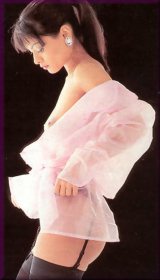

Our ancestors preferred to mate with "beautiful" individuals in order to leave more, and healthier, offspring than the average individual in the population. The process of evolution then further emphasizes "beautiful" characteristics - in women the overhead of say an extra pound of flesh on the bust has proven to be a far more successful survival technique than say stronger muscles.
While sexual equality may be vogue, in reality the two predominant genetic (XX and XY) sexes are drifting ever further apart in their physical appearance. In particular women are still evolving to appear ever more beautiful and youthful - and evolving far more rapidly than men. Men are not evolving towards their model of beauty at the same rate as women because an ugly but rich and high status man can be successful in attracting a good quality mate. A statistical analysis of "beautiful" Hollywood couples shows that their first child is 67% more likely to be a girl than a boy - nature somehow seizing the chance to maximize the birth of child of the sex for whom beauty is the more important.
It seems quite possible that in a few hundred generations time the average 35 year old woman could have the looks and figure of a 20 year old Playboy model today - and without the surgery. In the context of this site, a middle aged male-to-female transsexual worried about passing as a woman should perhaps be thankful that evaluation hasn't had another 10,000 years to work on homo sapiens!
Youthfulness and Health
Despite the current legal war against ageism, people's perception of whether a woman is beautiful is still (and will surely remain) closely linked to her age. While no age is given for the beautiful Cinderella, there are strong indications in the story that she has not long ceased to be a girl in the biological sense, and is certainly still a teenager.
A common finding in studies is that males prefer females who are young, strong and healthy - but above all who are fertile and at the peak of their reproductive potential. A woman's ability to bear children is dependent upon her age and hormone levels. A woman is at her reproductive peak around the age of 20, even with the support of modern medicine (HRT, IVF, ...) her fertility has declined two thirds by age 44, and it's usually spent by 54.
In one cross-cultural survey, men in all 37 of the societies examined preferred younger wives, on average around 2 ½ years younger than the male. And as males get older, they prefer mates who are increasingly younger.
If a woman is ever going to be considered "beautiful" it's in the years from her late puberty (typically 15 or 16), when her body has fully rounded out, to her early 20's, before gravity and the passage of time have started to work their first ravages. The male eye is astonishing good at picking up the first sign of aging in an otherwise perfectly youthful beauty - signs of character around the eye's, bad teeth, or less than firm buttocks and warning lights flash and marks are subconsciously deducted.
The female face is particularly easy to read for signs of aging. The youthful woman has large eyes and plump lips. The apparent size of these features peaks in the early 20s when fertility also peaks. As fertility declines, the lips dry and shrink, the skin wrinkles and the flesh round the eyes causes them to look smaller.

Age is the foremost enemy of beauty, but ill health and overexposure to sunlight also take their toll. Wrinkles are not due purely to chronological age. Most skin specialists say that the majority of wrinkles are due to sunlight, as a result of constant exposure to the sun the face skin ages more quickly and more visibly than any other part of the body. Avoiding the Sun is the best way to prevent or delay wrinkles, although we do need some natural light for health, while sunbathing will considerably hasten it.
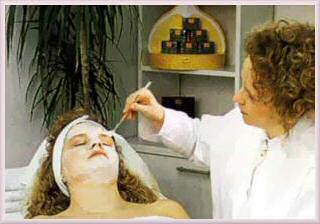
But the effects of aging do other things to the face as well. Gravity plays a big part. The jowls drop and the fatty tissues beneath the skin break down as cells are replaced less often. The face of youth is a triangle shape - at its widest at the cheekbones. The face of age is more like a square with the chin competing for dominance. The cheeks sink in and the skin looks less fresh because the epidermal cells have slowed down their rate of renewal. Melanin in the hair stops renewing itself and the hair turns grey or white. Strangely though, the eyelashes retain their colour throughout life, never turning white.

Genetics also plays a part in aging. As melanin protects the skin from wrinkling, the people who are likely to show their age most quickly are freckly redheads, who have less melanin than others.
Good luck as regards genes, combined with a healthy life style and regular exercise can delay things, but by age 30 at the very latest, even a supermodel will lose the allure of youthfulness when unaided by cosmetics, surgery and supporting garments.
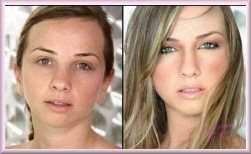
A model, before and after makeup.
|
With the help of such artificial aids most women seek the appearance of eternal youth - but at great and ever increasing cost in time and money. The average American woman spends nearly one hour a day (two or even three hours isn't uncommon) on beauty care and maintaining her appearance:- bathing, makeup, hair, nails, depilating, massage, exercising, selecting her attire, etc.
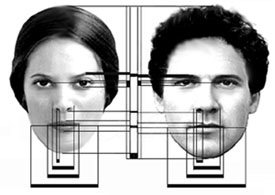
Symmetry
One key to physical attractiveness is symmetry; humans, like other species, show a strong preference for individuals whose right and left sides are well matched. John Manning of Liverpool University has reports that symmetrical men have higher quality sperm, with fewer deformed ones in the mix. He claims that symmetry is like nature’s black box - it tells you all you need to know about someone’s genetic history.


For both men and women, greater symmetry predicts a larger number of past sex partners, and a 1994 study found that the most symmetrical males had not only had more off-spring than their most lopsided brethren, but started having sex three to four years earlier! Also, a survey of 86 couples found that women with highly symmetrical partners were more than twice as likely to climax during intercourse (an event that may foster conception by ushering sperm into the uterus) than those with low-symmetry partners.
Studies show that highly symmetrical people are healthier, grow faster, and are better able to survive, while low-symmetry has been linked to schizophrenia, mental retardation, birth pre-maturity and left-handedness. Facial symmetry is certainly associated with health. After analyzing diaries kept by 100 students over a two-month period, researchers found that the least symmetrical had the most physical complaints, from insomnia to nasal congestion, and reported more anger, jealousy and withdrawal.

Neotenous Female Face
A key feature of female facial attractiveness is the extent of neotenous (infant-like) features that the face displays. [For more information on the form of the feminine face, see
here
]

As a rule, average faces are more attractive than unusual ones but the faces we find most beautiful are not average. When people are asked to develop ideal faces on a computer, they tend to exaggerate certain qualities. A 1993 study used a computer program which allowed participants to morph faces until they had achieved an ‘ideal’ face. The ideal 25-year-old woman as configured by participants had a higher forehead than an average one, as well as fuller lips, a shorter jaw and a smaller chin and nose. She had a 14-year-old's abundant lips and an 11-year-old's delicate jaw. Because her lower face was so small, she also had relatively prominent eyes and cheekbones.
An attractive face is not average!
|
The most attractive face shape is not average. In one study, pictures of 60 female faces, aged 20-30 and without makeup, were rated for attractiveness by male and female subjects.
|
| An "Average" face (A) was made by blending 60 female faces into an average. |
| An "Attractive" face (B) was made identifying the facial shape of the 15 most attractive female faces and then adjusting the average face to this shape. 90% of male and female Caucasian subjects preferred this to the average shape (A). |
| An "Enhanced" face (C) was formed by exaggerating the shape differences between images (A) and (B) by a further 50%. 70% of the subjects preferred this to image (B). |
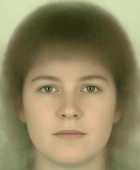

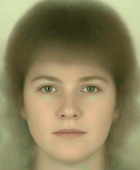
(C) Enhanced face
|
|
|

|

|
Note the baby faced looks of this model:- the proportions of her face are very child-like.
|
Evolutionary psychologists have found that the facial features that we obsess over are precisely the ones that diverge in males and females during puberty, as floods of sex hormones wash us into adulthood.
|

A classically female oestrogenized face. The woman is actually genetically XY karotype but suffers from
CAIS
- this prevents any hormonal masculinization and by default maximizes feminine features
|
Men see as beautiful in women the residual child-like facial features that are influenced by the presence of the female hormone estrogen, or perhaps more correctly the absence of features that would be induced by the high levels of male androgen hormones such as testosterone - which may obliquely indicate low fertility. Such estrogenized features (large eyes, high cheek bones, small nose, small chins, full lips, short eye-chin distance etc.,) are regarded as being very attractive and may be seen as an indicator of youth and female fertility, and hence reproductive potential. No one claims that a fine jaw reveals a woman's exact odds of getting pregnant, but like her breasts and figure it might imply that she could and is worth a male investing in her as a potential mating partner. One study demonstrated that male volunteers not only consciously prefer women with small lower faces, but also have marked rises in subconscious brain activity when looking at pictures of them!
|
 Emma Bunton -
"Baby Spice"
Emma Bunton -
"Baby Spice"
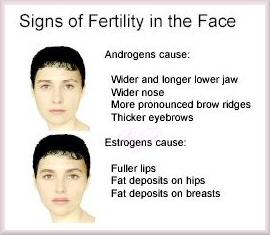

|
THE SCIENCE OF ATTRACTION
|
Victor Johnston
, a psychobiologist at New Mexico State University in Las Cruces, found that the heart-shaped face, small at the jaw with wide eyes, combines elements that are particularly desirable to men. Johnston suggests that such features are attractive to men because they are indicative of fertility.
|
The modified face (Femme Fertile) was constructed by warping the composite face (Plain Jane) to enhance oestrogen effects and decrease androgen effects. Androgens cause a wider and longer lower jaw, a wider nose, and more-pronounced brow ridges with thicker eyebrows (causing the eyes to appear narrower and deeper). All of these characteristics appear on male faces at puberty, and females who lack such features are found to be more attractive. Estrogens cause fat deposits on hips, breasts, and lips; this also enhances female attractiveness
.
|
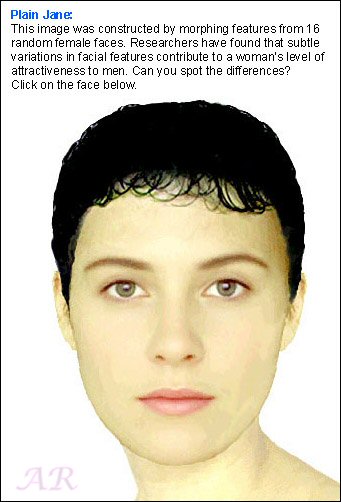
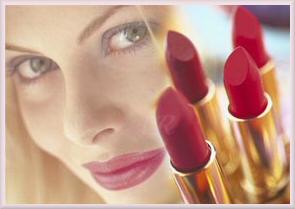
Any cues to illness or advanced age (wrinkles, grey hair, poor complexion, facial blemishes, poor teeth, etc.) are universally rated as being unattractive. Books on the use of cosmetics are essentially manuals on how to accentuate youthfulness and the neotenous and symmetrical facial features that are known to be reliable health and fertility indicators. With the development of plastic surgery these much desired and admired features of human female beauty can be acquired in a more permanent state, as compared to the temporary state of cosmetics. Almost all plastic surgery attempts to correct asymmetries and exaggerate traits that are generally considered to be beautiful - and subconsciously reliable indicators of youth, health and fertility.
|
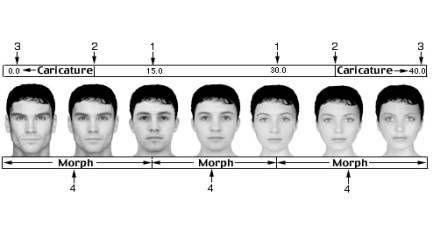
Labels
1. Initial "average" male and female faces.
2. Masculine or feminine facial features and proportions added.
3. Caricature of extreme male and extreme female faces.
4. Combined morphed face
|
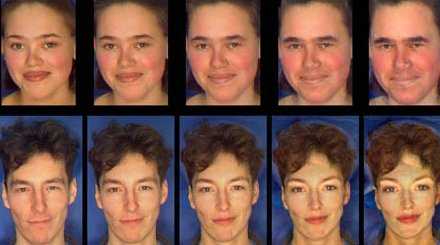
The picture second from the left is of a woman (top) or man (bottom). Masculine or feminine facial characteristics are progressively enhanced in the photos to the right or left.
|
Waist to Hip Ratio (WHR)
There's no doubt that a slim waistline between shapely hips and prominent breasts makes a woman highly appealing, this is regardless of the woman's overall body size and weight - a low waist-hip ratio is one of the few features that a tall, lean modern Barbie doll shares with a short, plump, primitive fertility icon!




Before puberty and after menopause, females have essentially the same waistlines as males. But during puberty waves of sex hormones start circulating in the body, high levels of the male hormone testosterone causes boys to amass in their upper body the bone and muscle of Stone Age hunters, while a high concentration of estrogen in the female body results in the typical girl gaining nearly 35 pounds of so called reproductive fat deposited on the hips and thighs, rather than on the waist. Those pounds contain roughly the 80,000 calories needed to sustain a pregnancy, and the curves they create provide a gauge of reproductive potential. Devendra Singh, a University of Texas psychologist notes "You have to get very close to see the details of a woman's face, but you can see the shape of her body from 500 feet, and it says more about mate value.".
|

The sex differences in fat and tissue distribution can be assessed by measuring the waist at its narrowest point, and the hip at the level of the buttocks, and computing a waist-to-hip ratio (WHR). After puberty the female WHR becomes significantly lower than that of the male - the typical female range being between 0.67-0.80; while the typical male range is 0.85 - 0.95.
|
Studies have found a strong link between the male fascination for Barbie doll curves (or small waist to hip ratios) in women and a higher disposition of fertility and health. This masculine preference for women with an estrogenized small WHR has sound scientific reasons...
|
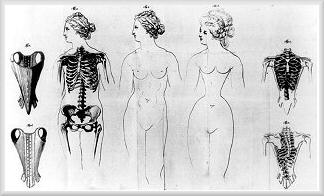
Being "beautiful" in Victorian times required a tiny waist (under 20" was common!) - regardless of the damage the
corset
did to a woman's body internally.
|
A growing body of evidence indicates that WHR is an accurate indicator of reproductive status a female with a more hourglass figure is more fertile and healthy than non-curvaceous or high WHR woman. Almost anything that interferes with fertility - obesity, malnutrition, pregnancy, menopause - changes a woman's shape. Healthy, fertile women typically have waist-hip ratios of 0.6 to 0.8, meaning their waists are 60 to 80 percent the size of their hips, whatever their actual weight. To take one familiar example, a 36-24-36 figure would have a WHR of 0.67.
|
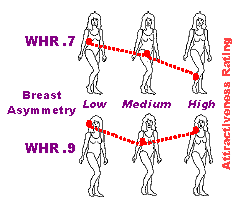
Waist-to-hip ratios (WHR) reflect the health and reproductive capability of woman, those with low WHR\s are judged by men to be more attractive and healthy.
Male college students were asked to judge the attractiveness of female figures that differed in WHR and breast symmetry. Figures with low WHR's were judged more attractive regardless of their degree of breast asymmetry. The figure with low WHR and symmetrical breasts was judged to be most attractive and youngest of all the figures.
It appears thus that men use both WHR and breast symmetry in judging attractiveness.
Many women outside this range are healthy and capable of having children, of course. But as researchers in the Netherlands discovered in a 1993 study, even a slight increase in waist size relative to hip size can signal reproductive problems. Among 500 women who were attempting in vitro fertilization, the odds of conceiving during any given cycle declined by 30 percent with every .1 increase in WHR. In other words, a woman with a WHR of .9 was nearly a third less likely to get pregnant than one with a WHR of .8, regardless of her age or weight. WHR also signals health status as the incidence of certain diseases (diabetes, hypertension, heart problems, strokes, etc.) vary with body fat distribution - a high WHR indicates a greater propensity to have such problems.
|

In 2007, a study by a team of Cambridge mathematicians found that it is the ratio between hips and waist that also puts a sexy sway into a woman's walk - and the nearer the ratio is to 0.7 the better. This ratio provides the body with just the right torso strength to produce a more angular swing and bounce to the hips during the walking motion. After studying various famous women, they concluded that the walk of actress Jessica Alba beat off rivals such as Kate Moss and even Marilyn Monroe, whose sashy along a railway platform in Some Like It Hot is one of the most famous in film history. While Monroe was a fraction off the target ratio, Alba with a 25in waist and 36in has the perfect proportions for a sexy walk!
|
Given the availability of such a revealing signal as WHR, it is not surprising that men respond by observing a woman's figure and consciously or unconsciously using it to infer her potential mating value.
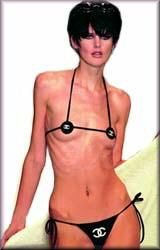
Men 'biologically' prefer curvy women with a pronounced hourglass figure, since these physical features of a woman are often associated with high fertility and good health. It is also likely that females enhance their attractiveness by emphasizing and advertising a low WHR through ornamentation and clothing. But contrary to popular opinion, the studies quoted above show that men prefer the average-sized female figure, as opposed to one that is particularly thin or fat - which may indicate fertility problems. In addition, a higher ratio is also obviously indicative of pregnancy, which would be of particular concern to a man seeking a mate with whom to bear children! A Weekend Post/Compas Inc. poll echoes this male preference. More men ranked "well-proportioned curves" and "curvaceous and voluptuous" far higher that the choice of "thin and straight body like a magazine model."
|
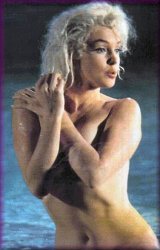
It is perhaps unsurprising to find that the voluptuous but 'wasp' waisted Marilyn Monroe has nearly perfect proportions for men, her quoted weight and measurements fluctuate somewhat during her 20's and 30's, but her bust is usually given as 36-38" and her waist as 23-24" - in practice her waist:hip ratio was probably consistently about 0.65.
|

A beautiful woman? Women are far more likely to think so then men.
|
Interestingly, women in the U.S., when asked to rate female figures toward the "ideal," consistently choose thinner figures than their male counterparts.
Western women are bombarded by magazine articles, advertising images and television programs (e.g. ... Next Top Model) encouraging them to diet and exercise almost to extremis in order to be beautiful - items often written or scripted by other women.
It would seem that the current trend for girls to diet until they become seriously underweight is more due to peer pressure from other women than from men. Indeed emaciated women are likely to be unhealthy and infertile, and thus offer little attraction to men seeking to mate - surviving an eating disorder (or a famine) is one of the most common causes of female infertility. At the point where a woman drops below 5 percent total body fat, her body begins to cannibalize the less important organs for nourishment, including reproductive tissue. It's unfortunately no coincidence that many 'coat hanger' models and stick-thin actresses have difficulty having children.
Careful eating and regular exercise is undoubtedly an ideal to aim at, but in excess (anorexia being an extreme example) it can have a truly devastating effect upon a woman during what should be her most "beautiful", marriageable and fertile years.

In a pioneering 1993 study, Singh, asked participants to examine 12 randomly arranged line drawings that represented four levels of WHR at three levels of body weight (underweight, normal, and overweight) and rank them in order of attractiveness. In all weight categories, both male and female participants aged 18-22 rated the figure with the lowest 0.7 WHR as a being youthful, healthy, reproductively capable and as the most attractive. In a related study, Singh, compiled the measurements of Playboy centerfolds and Miss America winners from 1923 to 1990. Their bodies got measurably leaner over the decades, yet their waist-hip ratios stayed within the narrow range of .68 to .72. (Even Twiggy was no tube; at the peak of her fame in the 1960s, the British model had a WHR of .73.) Small wonder that when women were liberated from corsets and bustles, they took up girdles, wide belts and other waist-reducing contraptions! Last year alone, American women's outlays for shape-enhancing garments topped a half-billion dollars. |
|
In a follow-up study, older participants aged 30-60 carried out the same procedure and produced the same ratings, overall males and females rated the figure of normal weight with the WHR of 0.7 as being attractive, youthful, healthy, and reproductively capable. Interestingly, the underweight figure with a WHR of 0.7 whilst being rated as the most youthful, was not rated as being the most attractive or reproductively capable. This is perhaps because this figure is perceived as being sexually immature. WHR could magnify the sexual attractiveness of the ‘hourglass figure’ - shapely breasts and broad hips set against a narrow waist. A high WHR may give off warning signals of low reproductive value and high disease risk, but may also give the appearance of pregnancy!
|

In a follow-up study Singh & Young (1995) addressed the role of differing body size, WHR and breast size in attractiveness. They found that the slender figures were judged to be more attractive, healthy, feminine looking and desirable for both short- and long-term relationships, the slender figures with low WHR and large breasts were the most preferred. In a second experiment they devised a new set of stimuli in which all of the figures had a WHR of 0.7 but they differed only in terms of breast size and hip size. Attractiveness ratings were affected by hip and breast sizes, figures with large breasts and small hips were rated as significantly more attractive than figures with small breasts and small hips. The figures with large hips were rated as being unattractive irrespective of breast size.
|
|
Henss (1995) carried out a similar study to the original Singh (1993) experiment but also included male figures. It was found that the female figure with the WHR of 0.8 was considered to be most attractive but for the male figures the ratio of 0.9 was the most attractive. Overall underweight figures were thought to be more attractive than overweight ones, but were also considered as being less emotionally stable.
|
It has been pointed out that there are some problems inherent with using only line drawing (they are unrealistic), and considering only the WHR. A recent study (Tovée et al., 1998) used real pictures of women dressed identically manipulated to control for WHR and body mass index (BMI) and argued that the latter index may be the most important factor in determining attractiveness - small alterations in BMI had a large influence on attractiveness and this was of greater impact than alterations in WHR. There have also now been studies that demonstrate that a preference for low WHR's are not culturally invariant as was originally suggested - a few cultures don't find a WHR of 0.7 particularly attractive.
|
|




Breasts and Buttocks
The female breasts and buttocks are extremely potent sexual symbols of feminine beauty. Firm but well-rounded and shapely breasts and buttocks are powerful signs of a woman's health, youthfulness and ability to procreate. Their sagging is also one of the first signs of aging as a girl moves in to her mid-20's womanhood.
|

The Venus of Willendorf, carved about 23,000 BC
|
Archaeology seems to show that 20,000 years ago Stone Age men strongly favoured women with voluptuous breasts and prominent buttocks. It appears that men looking for a partner ignored skinny women and competed fiercely for females with the shapeliest buxom and bottom. The experts think that well-presented breasts and buttocks singled wealth, health and a good diet.
|
The perceived attractiveness and mating advantage of women with generous buxom and buttocks has almost certainly resulted in a steady increase in these features over the generations - in the fierce height of evolutions "survival of the fittest", their size and shape must have long ago moved from the realms of physical reproductive necessity to exaggerated exhibitionism to help attract a good mate.
|
For example only one-third of a female woman's breast tissue is actually associated with milk production - the rest is merely fatty tissue. Indeed, a large buxom is actually a survival handicap to a woman, but it's also a symbol to men that she must be healthy and fit in order to be able to afford to carry such an unnecessary overhead.
|
A female becomes very aware of her buxom and its effect on men as she steps out of her adolescence and attains youth. A girl gets rapid body changes between about 12 and 14 years of age - puberty - and her breasts start showing. Between about age 14 and 18 her breasts become fully rounded, but are still pert and firm, and they reach their peak in attractiveness. However, sometimes their growth is stunted due to hormonal imbalance, congenital defects or deficiency of nourishing diet - this reducing the girls attractiveness as a mate. After 18 the breasts gradually start sagging and lose their tautness from the effects of gravity, increasing age, and (as appropriate) illness, pregnancy, breast feeding, irregular menstruation, and eventually the menopause.
|
A similar process applies to buttocks - their attractiveness to men peaks in a girls late teens, thereafter they slowly become less firm and smooth. Girls in their thirties often start to experience unsightly skin dimpling - cellulite - this condition seems to be strongly related to hormones and in particular estrogens.
|
Although exceptionally shapely breasts and buttocks are a gift of nature to a woman, there are a few things that all women can do to maintain whatever she has been endowed with in the best possible condition, in particular regular exercise. The use of well-fitting brassieres to support the breasts from their developmental years was for a long time also strongly recommended, however recently the medical profession has come around to the opinion that unless very well endowed, bra's actually do little to preserve the shapely curves and firmness of young breasts, aging and heredity characteristics are the primary contributors to eventual breast sagging. These days the main reasons for wearing a bra are probably social pressures, for improved appearance, personal comfort, and when playing energetic sports.
|
Of course if all else fails, plastic surgery is now a real option that can dramatically improve a young woman's bust and buttocks, or successfully roll-back the years for an older woman.
|

Copyright (c) 2004, Annie Richards
Last updated: 21 March 2004


















 To a man, a beautiful woman is more than just a beautiful face - it's the total package!
To a man, a beautiful woman is more than just a beautiful face - it's the total package!















 Emma Bunton -
"Baby Spice"
Emma Bunton -
"Baby Spice"























